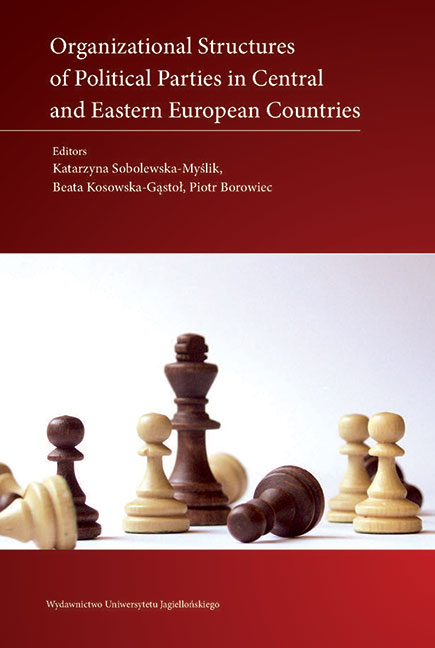Book contents
- Frontmatter
- Contents
- Preface
- Developing Party Structures in Central and Eastern Europe
- Albania: Organizations of Political Parties in Albania
- Belarus: Belarusian Political Parties: Organizational Structures and Practices
- Bosnia and Herzegovina: Organizational Structures of Political Parties in CEE Countries: A Case Study on Bosnia and Herzegovina
- Bulgaria: Organizational Structure and Trends in Bulgarian Party Politics
- Croatia: Organizational Structures of Political Parties in Croatia
- Czech Republic: Between Organizational Extremes: Czech Parties after a Political Earthquake
- Estonia: Organizational Structures of Political Parties in Estonia
- Hungary: Cut from the Same Cloth? A Comparative Analysis of Party Organizations in Hungary
- Kosovo: Structure of the Main Political Parties in Kosovo
- Latvia: Leader-Centered and Power-Hungry: Party Organizations in Latvia
- Lithuania: Organization of Political Parties: The Case of Lithuania
- Moldova: Organizational Structures of Political Parties in The Republic of Moldova
- Montenegro: Party Organization in Montenegro: Structural Resemblance Behind Political Divergence
- Poland: Structures of Polish Political Parties in the Second Decade of the 21st Century
- Romania: The Internal Organization of Romanian Political Parties
- Russia: Parties with Roots Growing Upwards: Organizational Features of Russian Political Parties
- Serbia: Organizational Structures of Political Parties in Serbia
- Slovakia: Organizational Structures of Political Parties in Slovakia: Parties not for Members
- Slovenia: Almost without Any Innovations: Organizational Structures in Slovenian Parties
- Ukraine: Shallow Party Structures in a Volatile Party System
- Comparing Organizational Structures of Political Parties in Central and Eastern European Countries
- Biographical notes about the authors
Albania: Organizations of Political Parties in Albania
- Frontmatter
- Contents
- Preface
- Developing Party Structures in Central and Eastern Europe
- Albania: Organizations of Political Parties in Albania
- Belarus: Belarusian Political Parties: Organizational Structures and Practices
- Bosnia and Herzegovina: Organizational Structures of Political Parties in CEE Countries: A Case Study on Bosnia and Herzegovina
- Bulgaria: Organizational Structure and Trends in Bulgarian Party Politics
- Croatia: Organizational Structures of Political Parties in Croatia
- Czech Republic: Between Organizational Extremes: Czech Parties after a Political Earthquake
- Estonia: Organizational Structures of Political Parties in Estonia
- Hungary: Cut from the Same Cloth? A Comparative Analysis of Party Organizations in Hungary
- Kosovo: Structure of the Main Political Parties in Kosovo
- Latvia: Leader-Centered and Power-Hungry: Party Organizations in Latvia
- Lithuania: Organization of Political Parties: The Case of Lithuania
- Moldova: Organizational Structures of Political Parties in The Republic of Moldova
- Montenegro: Party Organization in Montenegro: Structural Resemblance Behind Political Divergence
- Poland: Structures of Polish Political Parties in the Second Decade of the 21st Century
- Romania: The Internal Organization of Romanian Political Parties
- Russia: Parties with Roots Growing Upwards: Organizational Features of Russian Political Parties
- Serbia: Organizational Structures of Political Parties in Serbia
- Slovakia: Organizational Structures of Political Parties in Slovakia: Parties not for Members
- Slovenia: Almost without Any Innovations: Organizational Structures in Slovenian Parties
- Ukraine: Shallow Party Structures in a Volatile Party System
- Comparing Organizational Structures of Political Parties in Central and Eastern European Countries
- Biographical notes about the authors
Summary
Party organization is usually one of the least known aspects of party structure and behaviour, and the few pieces of literature that examine the organization of political parties are based mostly on the specific profiles of Western European parties. In a narrow sense, party organization refers to the different internal organizational structures of a political party, ranging from the basic unit to the central party organizational level, i.e. from the party membership to its leadership. For a more detailed conceptualization, we must look at the following: levels of constitutional and statutory regulation of party activity, behavior, and public funding (van Biezen 2008); party organizational strength and its bureaucrati-zation (e.g. Gibson et al. 1983); the importance of the party's membership to its electoral support (e.g. Kopecký 1995); the procedures and degree of membership participation in the nomination and selection of candidates and party leaders (e.g. Pennings and Hazan 2001); the degree of power concentration within a party as well as its centralization (e.g. Katz and Mair 1995); and finally, the relationship between the central organization and the party in public office (e.g. van Biezen 2000). Exploring the puzzle of party organization is therefore a central issue for the understanding of a political party.
This article takes a deeper look at the abovementioned aspects of party organization in Albania through a detailed analysis of the content of national legislation on political parties, statutory norms, and the current power structures of Albanian political parties. In addition to the formal “official story” of party organization, we also consider the behavior of party actors and informal data in order to fully understand the real internal organization of parties in Albania. In order to examine more carefully the party organizations in Albania, we have taken into account only the main parties from the left and right spectrum that have existed since the fall of communism and have been continuously represented in parliament. The two main political parties with the above key features are the Democratic Party (DP, Partia Demokratike e Shqipërisë), and the Socialist Party (SP, Partia Socialiste e Shqipërisë) of Albania.
- Type
- Chapter
- Information
- Organizational Structures of Political Parties in Central and Eastern European Countries , pp. 21 - 40Publisher: Jagiellonian University PressPrint publication year: 2017



